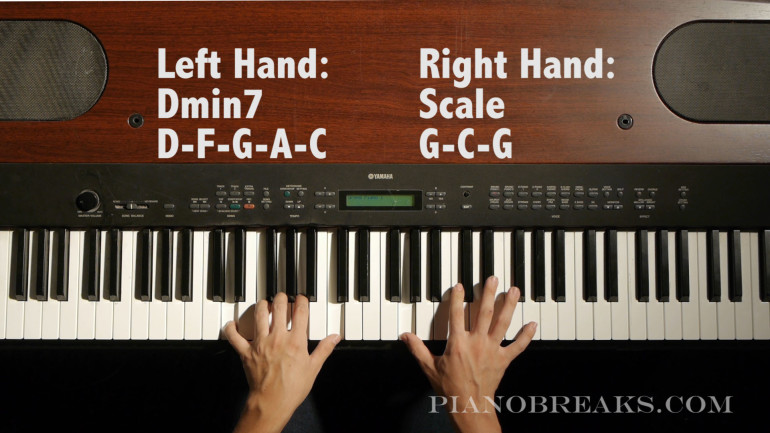
How to Form Major 7th Chords
Major chords are chords that are built on the major scale. There are many major scales, but to keep it simple let’s focus on the C major scale and form a major chord from there first.
C Major scale – All white keys starting from C
(C is the note to the bottom left of the pair of black keys)
C D E F G A B C
1 2 3 4 5 6 7 8
In a scale, the first note is called the 1, the second note is called the 2, the third note is called the 3, and that numbering continues until you get to the ‘8th,’ which is the same note that you started with.
Forming a C Major 1 3 5 7 Chord
To form a major chord, play the 1, 3, 5, and 7 of the C Major scale in your left hand.
Left Hand – 1 3 5 7 – C E G B
This C E G B is a major 7th chord, so it sounds nice and jazzy (It is called a major 7th chord because, rather than playing three notes (1 3 5) like a regular chord, the 7th note is included). Don’t worry if you don’t know about the theory too much. Just know how to play the chord and how to form it from a major scale.
Play the 2, 3, 5, and 7th notes in your right hand to complete the chord. This will give you a full chord voicing.
C Major Full 2-Hand Chord Voicing
Left Hand – 1 3 5 7 – C E G B Right Hand – 2 3 5 7 – D E G B
Play both of these chords at the same time in your right and left hand. It should sound really beautiful and brilliant, just a really nice sounding chord. I call this a 1 3 5 7 chord, because your left hand is playing 1 3 5 7 and your right hand is adding extra notes on top of it (a 2 3 5 7).
You can form this chord with any major scale or minor scale that you learn in the future, so keep that in mind. If you ever want to form this chord again, all you have to do is take the 1 3 5 7, play it in your left hand, and play the 2 3 5 7 in your right hand.
Forming An F Major 1 3 5 7 Chord
The F Major scale is F-G-A-Bb-C-D-E. If you wanted to form a 1-3-5-7 chord, the notes would be F-A-C-E. Even though the notes are different, the chord still sounds great because we are playing the same chord (1 3 5 7 chord) for a different major scale
F Major
Left Hand – 1 3 5 7 – F A C E Right Hand – 2 3 5 7 – G A C E
If you go between the F Major chord and the C Major chord you already know, it is called a 4-1 progression, which is a very beautiful progression that is used a lot, especially in contemporary music.
There are many other variations you can play by going between two major 1 3 5 7 chords too by trying different combinations, starting on different notes , learning their major scale, and forming 1 3 5 7 chords (C and Eb are good choices for this). If you like, try finding Eb major’s 1 3 5 7 chord and I’ll put the answer below.
Eb major 1 3 5 7
Left Hand – 1 3 5 7 – Eb G Bb D Right Hand – 2 3 5 7 – F G Bb D
If you have any questions about incorporating major chords into your playing, please let me know.
This is just to get you started, but there are obviously many other concepts that can help you navigate major chords in a way that you can use immediately in your playing, rather than learning something that is hard to apply. You should be able to form 1 3 5 7 chords now, and for any major scale you learn, you now know a way to play a full major chord voicing by playing the 1 3 5 7 and 2 3 5 7 notes whenever you like.
